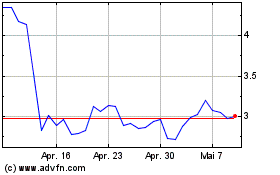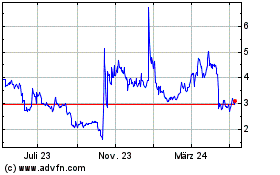Portal Removes The Need For Wrapped Tokens And External Custodians For Cross-Chain Asset Transfers
16 Februar 2022 - 7:46PM
NEWSBTC
Cross-chain bridges can unlock tremendous potential in the crypto
world. But, unfortunately, this technology has certain issues and
the wrapped tokens they use. Portal wants to change that narrative
by removing the need for wrapped assets or third-party custody of
user assets. Cross-Chain Bridges Are A Security Risk Those are the
findings of Ethereum co-founder Vitalik Buterin, uttered last
month. There is a good reason why Buterin uses harsh language, as
cross-chain bridges are prone to 51% attacks. When such an attack
occurs, hackers and other culprits control the system and can
defraud users. Although a 51% attack is not a permanent problem,
attackers’ possibility to steal funds needs to be nipped in the
bud. These bridges wrap and lock funds on other chains to
facilitate transfers in their current form. It is an elegant
solution, although one that introduces unnecessary security
concerns. More specifically, the wrapping and locking aspect isn’t
decentralized or trustless. Additionally, that approach can lead to
security incidents, such as the ones affecting MultiChain,
THORChain, pNetwork, Poly Network, and others. Staghead Crypto Head
Neil Player adds: “Cross chain bridges present a unique set of
security risks and these types of exploits are not a surprise. It
is a reminder how bleeding edge a lot of the applications that run
on top of blockchains are. Exploits such as what occurred on
Wormhole are expected to cause growing pains as the technology and
techniques associated with bridging assets matures.” The Poly
Network attack made headlines as it is the largest hack in the
decentralized finance space to date. Roughly $600 million in assets
were stolen – and later returned, thankfully – confirming the
vulnerability of these cross-chain bridges. Sadly, Wormhole lost
120,000 Ether – or over $320 million – due to insufficient
validation protocols for “guardian” accounts. Unfortunately, too
many security incidents involving these bridges warrant much
optimism. Portal Has A Viable Solution Addressing the core risks
with cross-chain bridges is paramount. There are too many attack
vectors for assets across a wider network. Moreover, most bridges
use centralized federations and external validators to process
transfers, even if that reduces the reliability of decentralization
and trustlessness. Portal aims to change the game through its
Bitcoin-based cross-chain DEX. It does not use wrapped tokens or
third-party custodial solutions. Instead, funds of participating
users are locked during trade execution, without replication on
other chains or re-bonding. Transactions occur via peer-to-peer
atomic swaps, letting users trade Layer-1 assets without delays,
exploits, or blocked funds. Portal executive chairman Chandra
Duggirala explains: Bridges are hard to reason about and secure.
Wrapping assets on other chains basically inherits the guarantees
of an IOU. When hundreds of Millions and Billions of dollars are
being secured by poorly engineered systems and custodians with
untested security practices, it becomes hard to secure user funds.
Especially given the balance of incentives, with hackers and
attackers basically having to get out of jail free cards due to the
“code is law” nature of public blockchains, security is especially
important. We like simplicity, and trusting proven, lasting
contract types and transaction models that Bitcoin has versus all
sorts of experimental approaches to real user money.” By removing
the need for wrapped assets and locked funds, transactions complete
in full or not at all. Furthermore, if both parties do not receive
the exchanged assets correctly, the Portal transaction rolls back
automatically. It is a crucial step toward eliminating the risk of
exploits at any transaction stage. All transfers are anonymous and
leverage zero-knowledge technology, making DeFi a more appealing
concept than relying on ineffective, hack-prone cross-chain
bridges. Image: Pixabay
BOND (COIN:BONDDUSD)
Historical Stock Chart
Von Mär 2024 bis Apr 2024

BOND (COIN:BONDDUSD)
Historical Stock Chart
Von Apr 2023 bis Apr 2024

Echtzeit-Nachrichten über BOND (Cryptocurrency): 0 Nachrichtenartikel
Weitere BOND News-Artikel